History: 1990-1999
1990
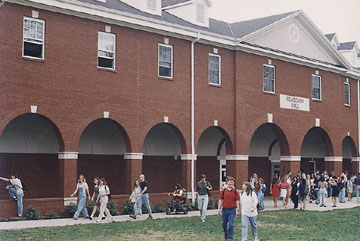 Construction began on Reasoner Hall, the final phase of the Morrison-Hughes renovation.
Construction began on Reasoner Hall, the final phase of the Morrison-Hughes renovation.
George Luce died suddenly in July. Kinlaw termed his loss “devastating” to the College and to himself. Robert E. Sunderland was elected chairman of the Board.
In the fall the social rule against beards was ended. Men were allowed to wear “neatly trimmed beards,” but these could not be grown while the student was on campus. He had to appear with a proper beard grown during summer vacation or over Christmas. The rule against shorts and women in pants and slacks in the academic areas of campus was ended. These items of dress were allowed in certain times and areas.
Broadcast communications students helped to broadcast the Goodwill Games in Seattle.
A summary of the majors chosen by over 10,000 graduates in the hundred-year history of the College, revealed the following percentages of the total, by academic division:
Social Sciences 20.6%
Education & Psychology 19.2
Religion & Philosophy 18.3
Science & Mathematics 14.1
English & Communications Arts 12.1
Fine Arts 6.2
No major listed 4.2
Physical Education 3.0
Foreign Language 2.3
A committee of trustees reported at the board meeting in October that discussions with a committee of seminary trustees about closer cooperation had gone pleasantly—and that the College should request that both institutions should take care that the words “College” and “Seminary” appear as large as “Asbury” in publicity materials. This would avoid confusion among donors.
During the fall quarter students were allowed to pre-register for classes in the coming winter quarter. This ended the traditional “arena registration” system.
The Asbury College Student Handbook was renamed Handbook of Community Life.
1991
Health problems, and the fact that the development staff insisted that Kinlaw visit major potential donors in person, compelled him to place much of the executive responsibility in Blue’s hands. A formal division of authority was inevitable. Upon Kinlaw’s strong endorsement to the Board, Blue was elected president. Kinlaw was made chancellor, to represent the college to donors and the wider constituency.
In order to satisfy a new postal regulation that the College have a definite street address to distinguish it from the Seminary, the administration named the front semi-circle Macklem Drive, in honor of the original donor.
Mrs. Willouise B. Luce was elected to the board at their April meeting. She was the first woman member of the board in 60 years.
Female students, faculty and staff were allowed to wear pants to all campus activities.
Reasoner Hall was opened. Work began on a new clinic building, named for the Alumni Association.
In the fall the College adopted the semester term calendar. Asbury was the last college in Kentucky on the quarter-term calendar system.
In the fall the Discipline Committee functioned for the last time in the enforcement of community life standards. Infractions of campus regulations were henceforth handled in the first instance by trained residence staff, and on the next level by professional counselors and administrators in the Office of Student Development.
David G. Lalka became vice president for institutional advancement.
W. Joseph Brockinton became dean of students.
The position of director of institutional research and planning was created. Arthur J. Nonneman, professor of psychology who had come to the college after a distinguished career at the nearby University, was the first incumbent.
By fall it was apparent that the change in titles had not entirely clarified the lines of authority between Kinlaw and Blue. Chancellor Kinlaw took a broad view of the opportunities for bridgeheads for evangelism in Eastern Europe opened by the collapse of the Soviet Union. President Blue concentrated on the restraints imposed by lack of money.
The “LEAD ON” leadership development program was started in Student Development, under Mark Troyer.
In December the College purchased the Reynolds Farm, comprising 341 acres along the Kentucky River Palisades. This completed a kind of circle, as the scenery along the Kentucky River had been one of the features that had drawn John Wesley Hughes to the Wilmore location in 1890.
On Christmas Eve the Union of Soviet Socialist Republics came to an end.
Also in 1991 Asbury was named one of “America’s top liberal arts schools” in The National Review College Guide. The criteria included strong commitment to teaching, a core curriculum based on the liberal arts and a clear sense of community identity, purpose and high standards.
1992
Kinlaw informed the Executive Committee of the Board in February that he would not go on as chancellor. The trustees urged him to take a long sabbatical and delay any announcement.
Blue was an experienced and skillful administrator. He gave strong leadership to long-range institutional planning. His approach was refreshing to many faculty and staff. Others found fault with Blue, who did not come from a traditional Asbury background. These differences of opinion regarding the president did not affect the activities of the College. The academic and other programs went on without disruption.
In March Bonnie Banker resigned as vice president and academic dean, effective in May. Blue named Judith S. Conde to replace her. The position title for W. Joseph Brockinton was changed to vice president for student development.
Reasoner Hall, which included an arcaded walkway facing the central campus, opened for use in April.
The Alumni Student Health Center was opened.
In June the board of trustees re-elected Blue as president. The position of chancellor was discontinued. The Board appointed a Presidential Performance Evaluation Committee to provide guidance and evaluation of Blue. In an effort to resolve continuing differences of opinion the board held special meetings at which comments were invited from individuals and groups of faculty.
Randy Richardson became Director of the Physical Plant.
In the fall enrollment reached a ten-year peak. The intercollegiate athletic program was expanded, to include varsity basketball for both men and women. In addition there were baseball, soccer and three other sports for men and five other sports for women.
Stephen P. Stratton became director of counseling. A full-time job placement officer was added.
The Luce Athletic Center project began.
A survey taken in late October showed a majority of the teaching staff supported the idea of finding “common ground” of theological and community values and agreed that Blue should be allowed to finish his term as president.
The Curriculum Committee, made up of the chairs of the academic divisions, voted to request faculty representation on the Board. When individual faculty members were polled, this proposal won overwhelming endorsement, with the additional provision that the faculty representative be elected.
The board meeting on Oct. 30 confirmed Blue as president by a narrow margin. The sharp division convinced him that he lacked a unified base of support, and he resigned. Several trustees including the chairman resigned as well.
The remaining Trustees unanimously elected C.E. Crouse, Jr., a partner in a major accounting firm, chair.
The Board turned almost by natural instinct to the one who had saved Asbury twice before in similar circumstances. C.E. Crouse and a small delegation of trustees explained to Cornelius R. Hager all that had happened, and that he alone could command the affection and respect of the entire campus community in this crisis.
Hager was 79 years of age and recovering from recent knee surgery. He was still in bed, in fact, when the Crouse group came to him with the proposal. Hager nevertheless stepped into the vacant position out of loyalty to the College. He became interim president for the third time, and confirmed his place as one of the heroes of this story. James Heidinger, executive secretary of Good News located in Wilmore, served as liaison between the administration and the board until Hager was able to take up his duties.
In November, William J. Clinton, Democrat, was elected as President of the U.S.
In December C.R. Hager became interim president of Asbury College for the third time.
1993
In February Crouse announced that the search for a new president would be broadly representational for the first time in the College’s history. The official Presidential Search Committee, included representatives from the trustees, faculty, students and alumni.
In May the Board elected David J. Gyertson as president. Gyertson, president of Regent University in Virginia Beach, was the first permanent president of the College with wide experience in academic administration. He was one of only two presidents since Morrison who was not a graduate of the College, and the first ever who was not a Methodist. He was also a television and radio personality.
In June the College administration building was renamed in honor of Cornelius R. and Ruth Hager.
In July Conde resigned. At Gyertson’s strong urging, C.R. Hager became acting vice president and dean, pending a national search for a new chief academic officer.
During the summer air conditioning was installed in the Johnson residence hall complex.
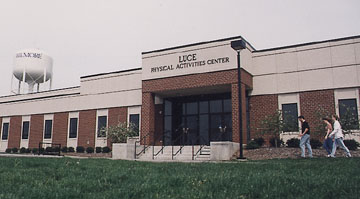
In October the George E. and Willouise B. Luce Physical Activities Center opened. The building was named in honor of the contribution of George Luce to the development of the College, and in recognition of a major contribution to the project from the Luce family as individuals and as part of a family foundation.
Asbury was again named one of the nation’s top liberal arts colleges in the second revised edition of The National Review College Guide.
1994
Raymond Whiteman became provost and academic dean. Formerly the dean of academic records and services at Wheaton College in Illinois, Whiteman was the first dean at Asbury in modern times who had academic training in administration. He was also the first who had not risen from within the campus academic community.
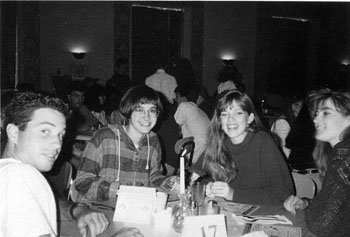 During the summer the student parking lot was paved for the first time.
During the summer the student parking lot was paved for the first time.
Gyertson, who had served as an administrator at Asbury Seminary, was committed to forming closer ties between the two institutions. When he learned that the Seminary was opening a new bookstore under the auspices of the Methodist publisher Cokesbury, he began to discuss a joint bookstore for both institutions.
The Broadcast Communication program, whose director was Jim Owens, won the CNN News Source Award for “excellence in broadcast journalism.” Asbury was placed in charge of one of eight training programs for broadcast interns at the Summer Olympics in Atlanta, coming in 1996.
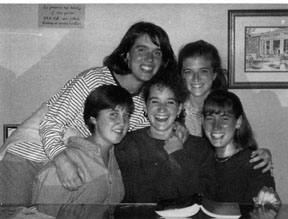
Gyertson introduced a new, more collegial form of administration. The administrative council was renamed the president’s cabinet. The title for the officer designated as second-in-command and chief operating officer when the president was away was changed from executive vice president to provost.
In May the Board, uncertain about the implications of including a third party in the proposed joint bookstore, withdrew from the discussions. For its part the seminary contended that its discussion with Cokesbury had proceeded to commitment.
Karl Wilson died in October.
1995
Stephen R. Boven became Wilmore chief of police on Jan. 1.
Gyertson worked closely with Chairman Crouse in introducing important changes in Board procedure. In April members of the President’s Cabinet were admitted to Board meetings in an advisory capacity for the first time. At the same meeting the new president proposed revisions in the Board’s by-laws, which in effect ended lifetime tenure.
In late March there was an unusual sense of the Holy Spirit in chapel, which resulted in an all-night prayer meeting in Hughes Auditorium.
During the summer the Trustees residence hall complex was air-conditioned. Phase I of Aldersgate Commons Student Apartments was started.
The academic divisions were abolished. The academic departments became free-standing units. The chairs of these departments and of faculty standing committees were made rotational. Committee membership was limited to three years. The new system was meant to give more faculty the opportunity for at least first-level administration for a few years and to expose them to the activities of a wider range of committees. On the negative side, the experience and prestige associated with senior faculty was lost.
In October the Board approved the proposed changes in its own procedure. Under the new provision (Article II, Section 3 of The Bylaws of Asbury College Board of Trustees), members could serve for two five-year terms. Then there was an obligatory absence for one year, after which a person could be elected again. The limit on active service was 20 years. After this, Trustees might continue to attend meetings in an advisory capacity, but without the vote.
At the same meeting the board declared support for “continued efforts in recruiting minority students.”
1996
In March new hymnals were placed in Hughes Auditorium—The Worshiping Church: A Hymnal.
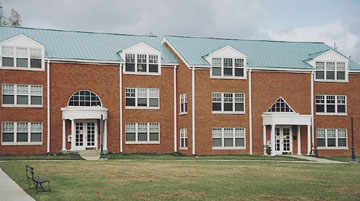
Aldersgate Commons, an apartment-style residential complex for upper division students, was opened in August. The four “Houses” within the complex were named for venerable campus figures: Joseph and Margaret Thacker, Leon and Annette Fisher, Maysel Davis, and William and Doris Eddy. A new photography laboratory was named for Ruth Seifert.
This year’s commencement was the last held in Hughes Auditorium.
During the summer Trustees’ men’s dormitory complex was air-conditioned. The Asbury Broadcast Communications team provided important logistical support at the Summer Olympics in Atlanta, Georgia. This gave the Asbury program broad exposure in the media industry.
In the fall Asbury College went online, with each faculty office supplied with a computer connected to the Internet.
In November William J. Clinton was re-elected as President.
1997
The position of “vice-chair of the faculty” was created. This was an elected office to serve as faculty representative to the administration, to organize and chair regular “faculty forums” to discuss subjects of interest to the teaching staff and to chair faculty meetings in the provost’s absence. Bonnie Banker was the first incumbent.
In May the Asbury College Equine Program was established on part of the Reynolds Farm property. Harold Rainwater was the founder and first director of this innovation, designed to wed part of Asbury’s recreation program to its Kentucky heritage.
Melvan Bowdan, who retired this year as director of multicultural relations, was elected to the Board, the first black trustee.
David G. Lalka resigned as vice president for institutional advancement. The position remained vacant for the next four years.
During fiscal year 1996-1997 the College endowment passed $20,000,0000.
The commencement this year was the first held in the Luce Center.
In the fall U.S. Army and Air Force Reserve Officer Training Corps [ROTC] programs were established on campus in affiliation with the University of Kentucky.
The Board also approved the introduction of graduate studies at Asbury by authorizing two programs—a joint Master’s degree program administered by the Business Management Department with East London University in Sussex, and a new Masters’ degree program in the Education Department. The latter program drew upon the strengths of the broadcast communications program as well.
Gyertson told the Board that many persons within the broad evangelical community were hungry for the “purity and the power of the Spirit” that formed the heart of the Asbury spiritual tradition. If Asbury moved beyond its “feeder constituency,” which was shrinking anyway, he predicted it would become “the leading independent holiness liberal arts college” in the country.
The name of the Foreign Missions Council was changed to the Great Commission Council.
A self study, part of the regular ten-year reaccredidation process required by SACSCOC, was launched.
Stuart Smith became associate dean for campus ministries. Part of his duties included serving as chair of the chapel committee, which previously had been a faculty position.
1998
Prof. Chuck Ruot became Athletic Director.
A major donor, who insisted upon anonymity, gave a large sum to the new library project, on the condition that the new building be named for Rev. Jiles E. and Eloise G. Kirkland. Because the board was committed to the Kinlaw name, it fell to Gyertson to negotiate with the donor. In the end, the donor generously agreed to naming the Jiles E. and Eloise G. Kirkland Learning Center, which occupied an entire floor of the new building. The anonymous gift in honor of the Kirklands was the largest single individual gift to the College up to that point.
Intercollegiate athletic scholarships were approved for the first time. The athletic program was required, however, to fund these on its own. No existing College funding sources were to be used.
The stage in Hughes Auditorium was substantially rebuilt. The new platform was more useful for performing groups, yet floor space was released for 80 additional seats.
The College received the largest single scholarship endowment in its history. Mr Charles I. Babcock, Jr., and Mrs. Willouise Luce made generous gifts along with the Southern Territory of The Salvation Army to establish the Miller Scholarship. This fund provided grants to Salvationist young people from the Army’s Southern Territory to assist them in attending the College, and was named in honor of Commissioner Andrew S. Miller.
A major revision of the Faculty Manual reflecting changes in the structure and function of departments and committees was approved.
Dr. Monica Ray became the College physician.
The position of director of multicultural programs and retention was moved to the student development department. Deborah Hazard was the first incumbent in the new position.
1999
The College self study was completed successfully. The few recommendations were technical and easily satisfied.
Jeff James became Director of the Physical Plant.
In June construction began on the new Kinlaw Library.
In July Jeff Anderson, a College employee, became chief of the Wilmore Volunteer Fire Department.
Mr. Steve Wise became Associate Dean for Resident Life.
In the fall the second faculty vice-chair, Ed McKinley, became the first elected representative of the faculty to sit with the Board of Trustees as a non-voting member. The same privilege was extended to a representative of the Asbury Alumni Association, Greg Van Tatenhove. Although this privilege had long been sought by faculty, it came now because of the strong endorsement of Gyertson and Whiteman.
The John Templeton Foundation Award for Exemplary Program was given to Asbury’s Student Leadership Development Program.
At a special board planning session and in other forums Gyertson, an energetic leader with a broad vision, called for “big hairy audacious goals.” He secured a commitment from the board to expand the College to at least 1,500 students, which was the limit set by existing facilities. Gyertson believed more was needed. He asked the board, faculty and friends of the College to cast a wider view upon the future. He suggested that Asbury might grow beyond 1,500—perhaps 2,000, or even 2,500—develop major new programs in communications, music and education and became a major spiritual and intellectual force in the new millennium. For these purposes he drew heavily upon nautical imagery, inspired in this perhaps by the chance arrival in his hands of an account of the launching of the victory ship Asbury 55 years before.
Earlier in October Asbury students won second prize in the annual Jessamine Jamboree Parade with a float featuring the Asbury ship.